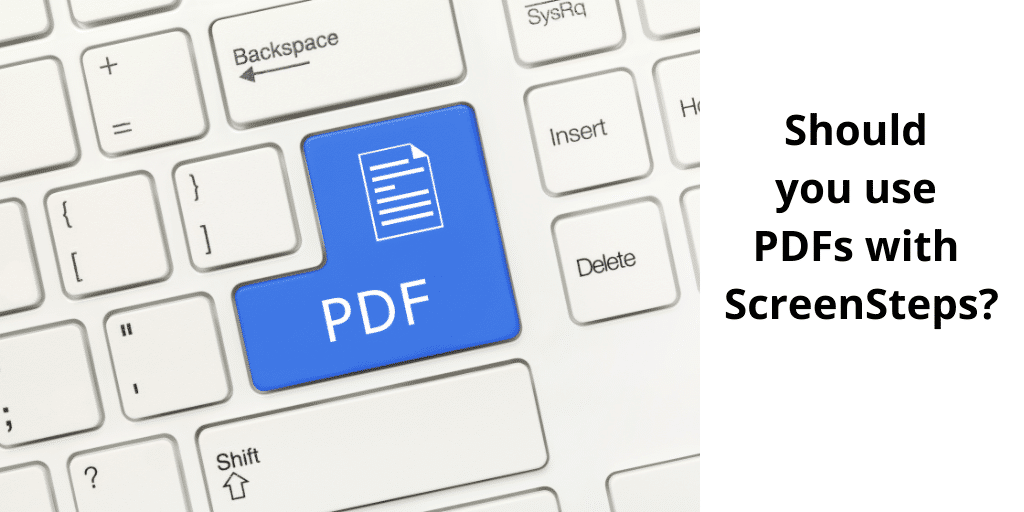Why you shouldn't use ScreenSteps to create PDFs (and when you should)

So, you just started a trial of ScreenSteps because someone told you it would be really easy to create guides with screenshots in them. Or maybe you just stumbled across ScreenSteps while you were searching around for a way to speed up the process of creating the help guides you need for your team.
And at this point, all you really want is to be able to create a Word or PDF file that you can give to people during training. You don't want to have to deal with publishing a knowledge base or having to send people logins to a new system.
PDFs are simple to create, simple to send, and simple to open. So why wouldn't you just use ScreenSteps to create PDF files to use during your training?
Because PDFs have a lot of problems that will prevent your training from being effective. In this article, I'm going to point out three of these problems. These aren't just small problems. These are big problems that will prevent your training from actually decreasing employee questions in the days and weeks after the training event.
Reason #1 - They don't update themselves
The number one biggest problem with PDFs is that they will not update themselves. How many times have you opened a PDF guide to try to follow it, only to find out that you have an outdated version?
Maybe a procedure changed. Maybe a screenshot needed to be updated. Or maybe a policy changed and your PDF is actually giving you the WRONG information!
The problem is that the PDF isn't going to update itself, so if there is a change you have to make sure that EVERYONE gets the latest version.
And that is no easy task. Many of your employees will have saved it to their hard drive, or, even worse, they have printed them out and have them in a binder next to their computer.
Getting them the current information is going to be tough.
But if you are using an online knowledge base, like ScreenSteps, you can make sure that everyone always has the latest information. Need to update a policy? Click publish and everyone has it. Need to update a screenshot? Boom - everyone has the latest version.
When employees have the latest and most correct information they will perform their jobs with fewer questions and fewer mistakes. PDFs will not allow them to have the most current information at their fingertips.
Reason #2 - Your employees can't find them
People love it when they see that ScreenSteps can generate an entire PDF manual, along with a table of contents. Other people come to us with PDF manuals that they have already created that are HUGE (we have seen some that are over 500 pages).
If your content is locked inside of one of these massive PDF files, your employees won't be able to find the information they need.
Think of the journey they have to take.
First, they have to find the right manual and the most current version of that manual.
Then they have to find what they want inside of that manual. This usually involves opening the document and hitting ctrl-F to search for some text. They then scan the results trying to find the section they need.
That is simply too hard and most employees won't do it unless they absolutely have to. Instead, they ask their neighbor or manager, or they just rely on their memory of how to do something which ends up slowing them down and increasing the likelihood of mistakes.
But if you put this content into articles in a ScreenSteps knowledge base, your employees can instantly find what they need and apply it. No more ctrl-F. No more trying to figure out if they have the latest version. No more downloading files to open them, only to figure out it was the wrong one.
Employees often comment that having a ScreenSteps knowledge base is like having an internal Google for their company, filled with the information they need to perform their jobs.
Reason #3 - They don't have interactive features that allow you to present information more clearly
Some guides are simple. Your employees just need the answer they are looking for. But some guides are complex. They may be filled with detailed instructions, if/then statements, decision trees, optional information, etc.
Complex information is hard to simplify in a PDF. There aren't really any interactive features to expose just the information the employee needs.
ScreenSteps, on the other hand, allows you to design the content experience so that the employee only sees what they need when they need it. Features such as foldable sections, pop up references, and Workflow Articles allow you to make complex procedures and information simpler to understand and simpler to apply.
These types of features aren't possible in a PDF so the employee ends up with a document that is either extremely confusing or one that doesn't deal with the real complexity of a procedure.
When is it a good idea to use ScreenSteps to generate PDFs?
So if PDFs are so bad, why does ScreenSteps allow you to create PDFs?
- Reason #1: Because they are good for archival purposes. If you need to store a snapshot of your guides at a certain point then PDFs are a great reason.
- Reason #2: Sometimes offline viewing is your only option. If your employees will not have an internet connection, then PDF will be the best option for storing guides.
- Reason #3: Sometimes you need to give a guide to someone who can't or shouldn't have access to your company knowledge base.
That is really it. If you look at those three reasons, you will notice that PDFs are always the backup plan. They are only used in cases where the online knowledge base is not an option for the employee.
What should you do next?
If you have only considered using PDFs up to this point, you should schedule a time with someone from our team to review what your training needs are and how you could better achieve your training and support goals by using the ScreenSteps online knowledge base instead of just using ScreenSteps to generate PDFs.
You can even send over one of your existing PDFs and our team will be able to show you how to use the authoring and presentation features in ScreenSteps to simplify your complex guides.
PDFs have their purpose and their place. But if you really want to drive exceptional training results, you will be better off using the online knowledge base that comes with ScreenSteps.

